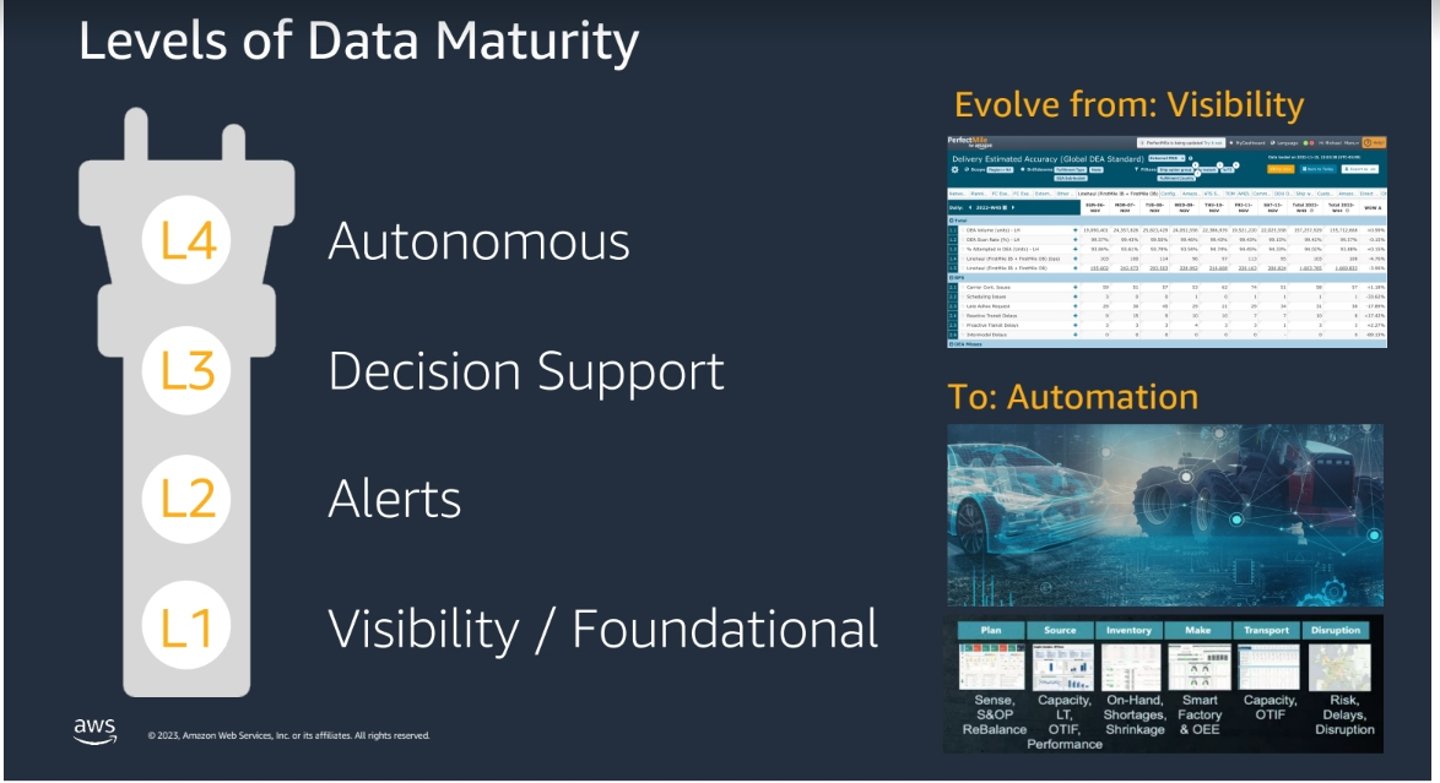5 Tenets of a Successful Data Products Strategy
Amazon Web Services (AWS) works with a vast majority of CPG brands worldwide—from the digital-native food and beverage brands to the largest fashion and apparel conglomerates.
For these firms, integrated data and analytics have been a top investment priority for many years—a trend that has only accelerated by the increasing availability of flexible, agile, scalable cloud platforms and new analytic capabilities that did not exist in the on-premise environment.
This widespread adoption of data analytics is reflected in the fast-growing demand for solutions in these markets:
- The data analytics market is projected to grow from $7.03 billion in 2023 to $303.4 billion by 2030.
- The analytics-as-a-service market is projected to grow from $9.2 billion in 2023 to $40.1 billion by 2030.
- The industrial analytics market is expected to grow at an annual rate of 15.4% and hit $54.7 billion by the end of 2030.
- The global artificial intelligence market is projected to grow from $515.3 billion in 2023 to $2,025.1 billion by 2030.
A common theme from our customers over the last five years has been their desire to become more data-driven. To uncover best practices for building data-driven organizations, our team worked closely with high-performing, data-driven groups within Amazon, AWS, and several forward-thinking CPG customers.
The result of our collaboration is a new approach to creating a successful data-driven organization called Data Products. It focuses on how to propose, prioritize, fund, organize, and deliver automation to achieve a positive business result. The Data Products approach is a departure from how analytics teams within IT operate today, but it should feel familiar to CPG leaders that have built their businesses around consumer products.
CPG manufacturers excel at product management. They deploy highly accountable brand owners, ruthless SKU optimization techniques, and efficient stage-gate routines to align and approve brand, product, packaging, price, and channel decisions across supply chain, manufacturing, and commercial teams. All are centered on a desire to create brands consumers love. Although Data Products represents a new approach to data and analytics, CPGs may be surprised by how much their existing product experience and culture apply to building a data-driven organization.
Current challenges
Why do some CPG manufacturers struggle with data and analytics investments? First, customers tell us they’re “data rich and insight poor.” The explosion of datasets over the last decade has been staggering and yet few feel they’re able to derive value from them. We also hear that when data does produce insights, they rarely translate into business action. Some leaders have made investments in this space in the past with little return on investment, so they’ve become justifiably suspicious of bold claims about the power of a new technology to make a difference in their business. Typical observations by customers include:
- “Meetings devolve into whose spreadsheet is right."
- "We have a lot of data, but it doesn’t translate into meaningful actions."
- "It’s like pulling teeth trying to find datasets and get access to them."
- "Once we get access to data, it’s hard to make sense of what it means."
- "We don’t get value from the investments we’ve made in data and analytics."
A common problem is that investments in data and analytics frequently fail to align with the company’s annual business goals and initiatives, leading to subpar outcomes. Data lake projects can lead to organizational bottlenecks. Deploying analytics and insights can require business process changes that the business is not willing to make. Analytics projects can stall due to the lack of ongoing operational funding. Most of these failures, however, have little to do with technology, but with the lack of adequate process adoption and methods to deploy.
Digging deeper
Let’s dive deeper into the Data Products approach. A data product uses data and automation to provide direct business value. Data product teams are agile and led by a product owner with ongoing funding and a small team that’s highly aligned with business stakeholders. A data product has clearly defined SLAs and metrics that measure how it performs against business goals. There are four levels of maturity for any data product:
- Visibility
- Alerts
- Guidance
- Automation (with automation being the ultimate goal)
As you think about a data product within your organization, ask yourself where it falls within this maturity model. Organizations just beginning their journey will likely focus on visibility while mature data organizations will have products ranging from visibility to automation with increasing focus on automation.
An example of visibility here at Amazon is an AWS Supply Chain Control Tower dashboard, which gathers data from various systems and provides a view into performance, operational issues, and status of product movement. This system allows business owners to see KPIs across the Amazon network of distribution centers, sort centers, fulfillment centers, and every mode of transportation that is used across the business.
Even though this is considered a visibility-level (low-maturity) example, there is still a lot of work needed to make it happen. In practice, delivering visibility like this requires a set of standard APIs for each component in the supply chain, integration into a centralized data warehouse to enable reporting and enforce data quality, data standards, and data access by role.
On the other end of the maturity model spectrum is data product automation. A good example of this is the product search function on Amazon. The vast majority of products purchased on Amazon are discovered using search, and improvements to the search algorithms can dramatically enhance the customer experience and lead to revenue gains.
There are a few interesting things about Amazon Search. First, it uses artificial intelligence trained from user actions such as add-to-basket, click, and purchases—and then retrained several times per day. It also considers all the data Amazon has from years of product searches and the resulting purchases. It also considers merchandising scores, prices, ratings, and reviews, so that Amazon is only surfacing products that customers will likely enjoy. Finally, it considers shipping speed and also presents a variety of different types of items if the customer search is high level. As a high-maturity “automation” data product, it has a product owner with a dedicated team and funding, and the product itself is fully automated.
Five Tenets of a Successful Data Products Strategy
Here are five keys to building and maintaining a successful Data Products strategy:
- Working backward. When proposing a new data product, work backward from the problem or business opportunity. At Amazon, teams use a set of questions to clarify the need for a data product. Who is the customer? What is the customer’s problem or opportunity? What is the most important customer benefit to be derived? How do you know what your customers want?
- Two pizza teams. Small, agile teams—so named because they require no more than “two pizzas” to feed—can move quickly with full accountability. They should have a product owner, key stakeholders, a product pipeline, and an operating plan. They are aware of key performance metrics and have well-defined goals.
- Prioritization with business objectives. Because many analytics initiatives are not aligned with annual business goals, getting business value from the analytics is often not realized. (One global CPG customer told us that 80% of the dashboards it builds are never used). This is exacerbated by the fact that centralized data teams often don’t understand the data or the area of the business they are trying to serve. The best data product teams are highly aligned with the business and demand commitments from leadership before delivering functionality.
- Service level agreements and KPIs. The data product has well-defined service levels for up-time, data quality, and response times. KPIs such as customer acquisition cost, forecast accuracy, and basket size all roll up to meet business goals for revenue growth and margin improvement.
- Roadmap. Successful data product owners will carefully curate a backlog of features based on input from business stakeholders. They’ll conduct operational planning to request ongoing funding based on team size and value for the business.
The Data Products approach is a new way of working that raises questions about data security, enterprise architecture, and governance. The fundamental difference is that Data Products create accountability on the data product team to deliver for the business. IT and enterprise architecture teams, in concert with the CISO, then become enabling functions as opposed to gatekeepers for cloud provisioning and tooling. Data product teams have to meet enterprise requirements around data security, privacy, and exfiltration of data but have flexibility in terms of how they meet those requirements.
Conclusion
In summary, integrated data and analytics will continue to be a top investment priority for CPGs for many years to come. As you think about a data product within your organization, ask yourself where it falls within the maturity model, and use our key tenants as a guide to build and maintain a successful strategy.
To learn more, check out our whitepaper, ‘Making The Shift to Data Products – The missing guide for how organizations become data driven’.
Further Reading
[1]Source: Market Research Future (MRFR)
[2]Source: Market Research Future (MRFR)
[3]Source: Market Research Future (MRFR)
[4]Source: Fortune Business Insights









